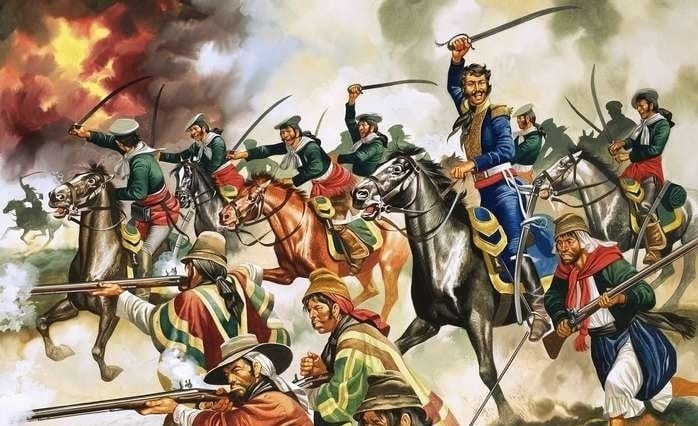The Struggle for Independence in Latin America
Dive into the history of Latin America's fight for independence in this newsletter.
Road to Spanish Fluency:
Learn More On The Course Here!
The history of Latin America's fight for independence is rich with stories of struggle, courage, and triumph. Beginning in the early 19th century, the region saw a wave of revolutionary movements that sought to break free from European colonial rule. The story of independence in Latin America is one of resilience and resistance, shaped by pivotal events and legendary leaders who are still celebrated today.
One key factor in these movements was the French invasion of Spain in 1808, which weakened the Spanish Empire and opened the door for independence movements in its colonies across Latin America. But how did this event help spark a wave of revolutions? Let’s take a look.
The Influence of the French Invasion
In 1808, Napoleon Bonaparte’s forces invaded Spain, taking control of much of the Iberian Peninsula. With King Ferdinand VII imprisoned, the Spanish monarchy was in turmoil. This power vacuum created an opportunity for Latin American colonies, which had long been suppressed under colonial rule, to question their loyalty to Spain and seek autonomy.
The French invasion indirectly led to the creation of juntas (local governing bodies) throughout Spanish America, which were formed to act in the absence of the Spanish monarchy. These juntas helped lay the foundation for independence movements by encouraging the idea of self-rule and challenging Spain's authority over the colonies.
Key Figures in Latin American Independence
Simón Bolívar - Known as "El Libertador" (The Liberator), Bolívar played a leading role in the independence movements of several South American countries, including Venezuela, Colombia, Ecuador, Peru, and Bolivia. His military genius and vision for a unified Latin America made him one of the most important figures in the region's history.
José de San Martín - San Martín is another key figure in Latin American independence, particularly in Argentina, Chile, and Peru. His successful military campaigns helped lead to the liberation of these countries from Spanish rule. San Martín’s determination and strategy were crucial in the Southern Cone’s fight for independence.
Miguel Hidalgo - The Father of Mexican Independence, Hidalgo led the famous Grito de Dolores in 1810, rallying thousands of people to revolt against Spanish rule. His actions marked the beginning of Mexico’s long struggle for independence, which would eventually be achieved in 1821.
Antonio José de Sucre - A close ally of Bolívar, Sucre was instrumental in securing victories in the battles of Ayacucho (1824) and Junín (1824), both of which were decisive in the fight for independence in Peru and the rest of South America.
Keep going to part two for more on key events, how the French brought about independence in countries they never visited, and why learning culture and history is an important step on your Spanish fluency journey!
Check Out My Latest YouTube Video Here!
How To Choose A Spanish Dialect To Study
Important Events in the Fight for Independence
The Grito de Dolores (1810): The spark of Mexico’s independence movement, led by Miguel Hidalgo, it marked the beginning of the Mexican War of Independence.
The Battle of Ayacucho (1824): A decisive victory for the forces of Bolívar and Sucre that ended Spanish rule in South America and secured independence for Peru and Upper Peru (now Bolivia).
The Declaration of Independence of Venezuela (1811): Bolívar’s early efforts to free Venezuela from Spanish control resulted in the creation of the First Venezuelan Republic, though it took years of fighting before the final victory in 1821.
The French Revolution’s Influence
The French Revolution (1789) also had a profound impact on Latin American independence movements. The ideas of liberty, equality, and fraternity spread across Europe and the Americas, inspiring Latin American revolutionaries who sought to overthrow monarchies and establish republics. Bolívar, for example, admired the French Revolution’s ideals and saw the opportunity to implement them in Latin America.
While the French invasion of Spain in 1808 opened the door for Latin American colonies to assert their independence, it was the revolutionary ideas and military strategies that helped transform these movements into successful campaigns.
Why Does This Matter to Your Spanish Learning?
Learning about these historical events and figures isn’t just about memorizing names and dates—it’s about understanding the context of the language you are learning. The independence movements shaped the culture, literature, and even the vocabulary of the Spanish-speaking world. As you continue your Spanish learning journey, you’ll encounter these terms and historical references in books, movies, and conversations, giving you a deeper understanding of the language’s evolution and significance.
Want to Learn More?
Be sure to follow me on YouTube for more in depth videos about Spanish and Latin American history and culture.
Check out TikTok and Instagram for more bite-sized learning. Hack your algorithm for growth and not just to kill time!
**********
Join My Spanish Classes!
If you're ready to take your Spanish to the next level, I’m offering personalized lessons that focus on both the language and the rich history behind it. Whether you're just starting or ready to improve your fluency, I can guide you through the process with practical lessons and engaging conversations.|
In honor of Semana Santa (Holy Week), you will get 15% off classes until the end of the month as readers of my newsletter. Contact me on WhatsApp for more details about private and group classes.
New Cohort Starts May 12
Mondays & Wednesdays at 9AM Mexico City Time
This is for learners who are ready to move beyond the apps, the flashcards, and the memorized phrases—and finally use Spanish to communicate and connect.
Ready to join us?
Check out the course info packet here
P.S. Want more tools to level up your Spanish on your own time?
Check out some of my most popular YouTube videos:
Nos vemos,
– Anthony







